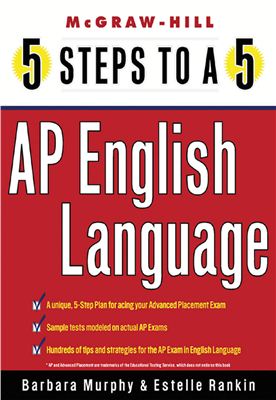Grace Freedson, Series Editor.
An exciting new series of study guides that lets each student design a course of study pitched to his or her individual needs and leaing style.
Publisher: McGraw-Hill.
Date: 2001.
Format: PDF.
Pages: 288.
Each year, more than one million U.S. high school students take one or more advanced placement (AP) exams, and, according to official projections, that number will continue to rise in the years ahead. That is because AP exams confer important benefits on those who do well on them. High AP scores are indispensable to gaining admission to most elite colleges. They provide students with a competitive edge when competing for grants and scholarships. And they allow students to bypass required university survey courses, saving on skyrocketing tuition fees.
Designed to coincide perfectly with the most current
AP exams, Five Steps to a 5 on the Advanced Placement Examinations guides contain several advanced features that set them above all competitors. Each guide is structured around an ingenious Five-Step Plan. The first step is to develop a study plan, the second builds knowledge, the third and fourth hone test-taking skills and strategies, and the fifth fosters the confidence students need to ace the tests. This flexible study tool is also tailored to three types of students. For the more structured student there is a "Month-by-Month" approach that follows the school year and a "Calendar Countdown" approach that begins with the new year. For students who leave studying to the last minute "Basic Training" covers the basics in just four weeks.
Other outstanding features include:
Sample tests that closely simulate real exams
Review material based on the contents of the most recent tests
Icons highlighting important facts, vocabulary, and frequently-asked questions
Boxed quotes offering advice from students who have aced the exams and from AP teachers and college professors
Websites and links to valuable online test resources, along with author e-mail addresses for students with follow-up questions
Authors who are either AP course instructors or exam developers
An exciting new series of study guides that lets each student design a course of study pitched to his or her individual needs and leaing style.
Publisher: McGraw-Hill.
Date: 2001.
Format: PDF.
Pages: 288.
Each year, more than one million U.S. high school students take one or more advanced placement (AP) exams, and, according to official projections, that number will continue to rise in the years ahead. That is because AP exams confer important benefits on those who do well on them. High AP scores are indispensable to gaining admission to most elite colleges. They provide students with a competitive edge when competing for grants and scholarships. And they allow students to bypass required university survey courses, saving on skyrocketing tuition fees.
Designed to coincide perfectly with the most current
AP exams, Five Steps to a 5 on the Advanced Placement Examinations guides contain several advanced features that set them above all competitors. Each guide is structured around an ingenious Five-Step Plan. The first step is to develop a study plan, the second builds knowledge, the third and fourth hone test-taking skills and strategies, and the fifth fosters the confidence students need to ace the tests. This flexible study tool is also tailored to three types of students. For the more structured student there is a "Month-by-Month" approach that follows the school year and a "Calendar Countdown" approach that begins with the new year. For students who leave studying to the last minute "Basic Training" covers the basics in just four weeks.
Other outstanding features include:
Sample tests that closely simulate real exams
Review material based on the contents of the most recent tests
Icons highlighting important facts, vocabulary, and frequently-asked questions
Boxed quotes offering advice from students who have aced the exams and from AP teachers and college professors
Websites and links to valuable online test resources, along with author e-mail addresses for students with follow-up questions
Authors who are either AP course instructors or exam developers

